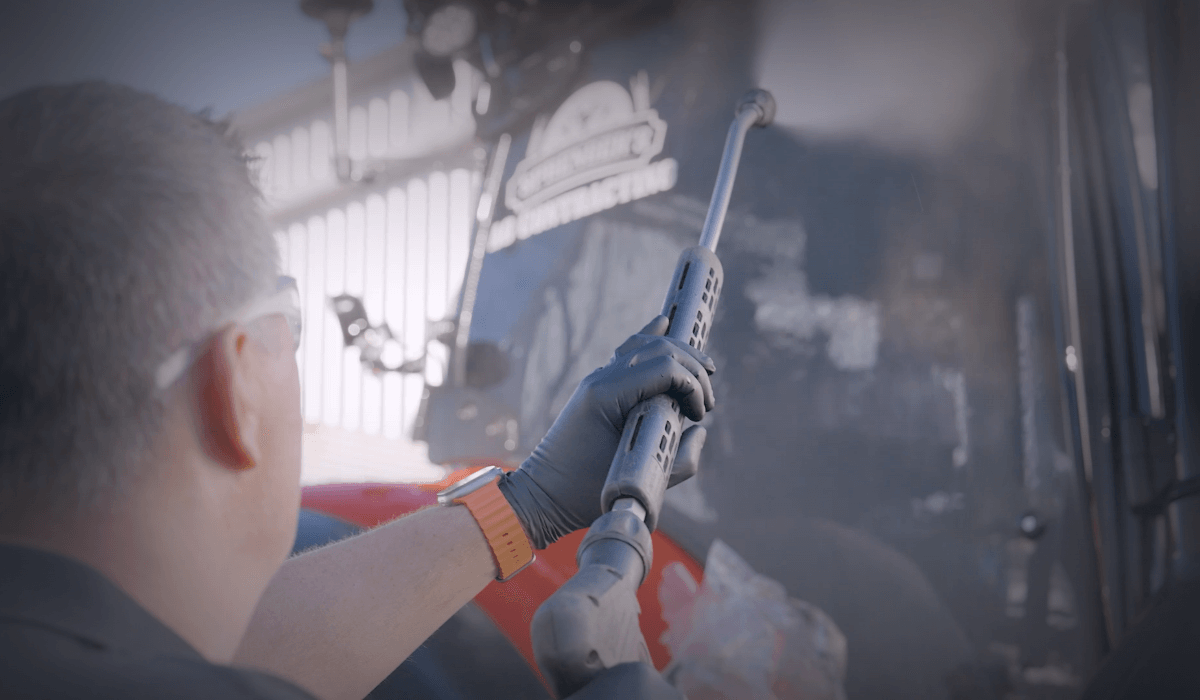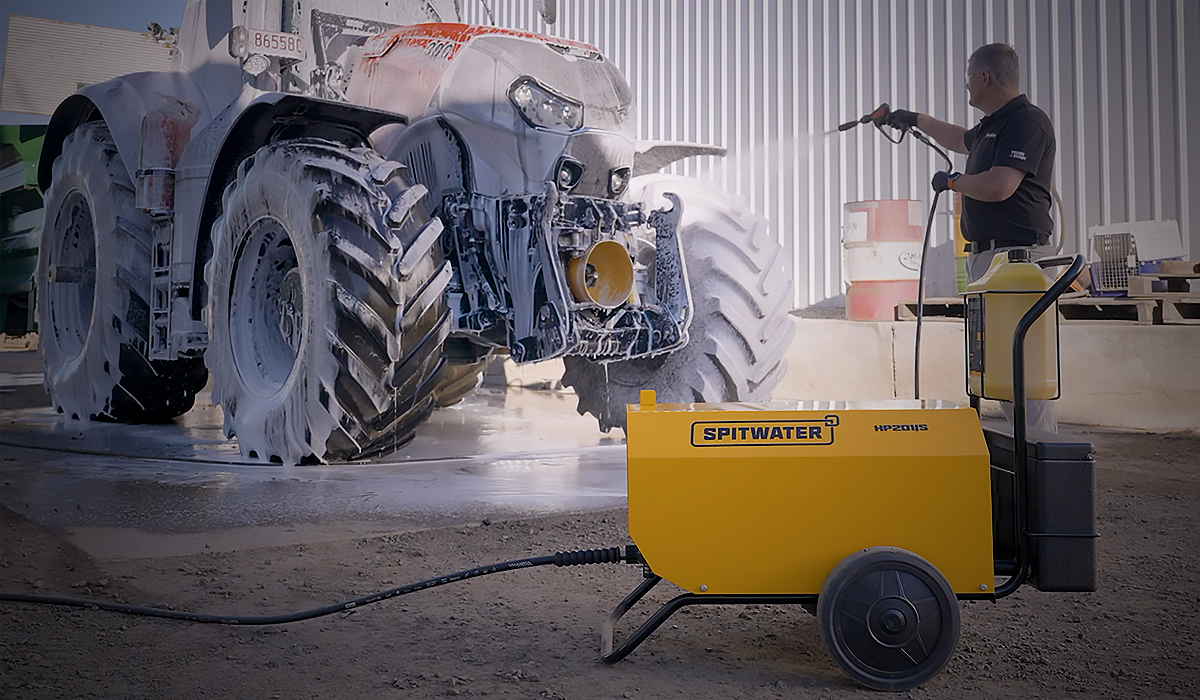Why Correct Flow Rate and Water Inlet Setup Matter
A pressure cleaner is only as good as its water supply. Even the most powerful SPITWATER machine will struggle if it’s not fed the right volume, pressure and quality of water.
Taking time to assess your site and set up the inlet correctly prevents faults, improves performance and extends your machine’s lifespan.
This article covers:
- Why your water source matters
- The rules of water inlet set-up
- What can go wrong
- Flow rate and pressure- better together
Why your water source matters
Before you start, identify where your water will come from. Town mains, tank water or bore water all have different flow rates, pressures and quality.
- Town water often has adequate pressure but can vary between sites.
- Tank water may need a pump to achieve the right flow.
- Bore water can contain minerals or grit that can damage components if not filtered out.


The rules of water inlet set-up for pressure washing
Your machine needs a continuous supply of clean water at the correct flow and pressure.
As a guide:
- Flow rate should exceed your machine’s litres per minute (LPM) rating
- Inlet pressure should be stable and within the manufacturer’s specified range
- Use a flexible hose between your water source and machine to absorb vibration and prevent strain on fittings
Problems caused by incorrect water supply
Incorrect water inlet set-up is one of the most common causes of performance issues and machine faults. Problems include:
- Float valve failures are typically caused by excessive inlet pressure
- Pump cavitation or damage occurs when flow rate is too low or hoses are incorrectly fitted
- Machine vibration and noise, often caused by rigid plumbing
- Interrupted cleaning and premature wear from inconsistent water delivery
.png?width=900&height=650&name=Leaking-pipes-water-inlet-issues%20(1).png)
Calculating your minimum required flow rate
Your machine needs a consistent and sufficient flow of water to operate correctly.
If the incoming water supply can't keep up with your machine’s demand, you risk damaging internal components.
General Guidelines
|
Machine Flow Rate |
Minimum Required Flow |
|
10 LPM |
12 LPM minimum |
|
21 LPM |
25 LPM minimum |
|
30 LPM |
36 LPM minimum |
Rule of thumb: Supply should be at least 20% more than the machine’s rated flow. This provides a buffer to avoid starvation or cavitation.
Too much inlet pressure can also be a problem - especially for machines with float valves, which typically max out at around 500 kPa (5 bar). Going beyond this can cause float valves to fail and the unit to leak.
What to do if flow is too low
If your water supply can’t deliver the minimum flow (e.g. only 15 LPM available but your machine needs 21 LPM), install a buffer tank.
Buffer tanks store reserve water to meet demand, preventing dry running and cavitation.
They're especially useful for:
-
- Mobile operators working at multiple unknown sites
- Sites with intermittent supply
- Jobs requiring high-flow machines (e.g. 30 LPM+)
SPITWATER offers compatible buffer tanks and low-level water shut-off switches for added protection.
Why rigid plumbing can be a problem
Connecting your pressure cleaner directly to rigid plumbing creates stress on the pump inlet. Any movement or vibration can crack fittings or strain components.
A flexible hose acts as a buffer, absorbing vibration and minimising surge pressure. It’s a simple fix that prevents a world of damage.

Recommended hose setup:
|
Machine Type |
Pump Type |
Inlet Setup Recommendation |
|
High-Speed Pump |
Direct fed |
Minimum 7m flexible hose |
|
Low-Speed Pump + Bypass Cooling Tank |
Gravity/suck |
Minimum 2m flexible hose |
|
Machines with Bypass Cooling Tank |
Any |
No minimum hose length |
Note: Even if you’re using a short run from a tap, at least the final 2 metres must be flexible.
What about water hardness?
Water hardness varies widely across Australia. From 100 ppm on the Gold Coast to over 400 ppm in Adelaide. High mineral content can:
-
- Accelerate scale buildup in hot water coils
- Cause abrasion in pumps
- Shorten service intervals
For hardness above 500 ppm, a water softener or chemical dosing pump may be required - especially for hot water machines.
Real-World Example
Car Rental Wash Bay - Rigid Plumbing
A rigid stainless-steel plumbing install caused a SPITWATER unit to bang violently every time the float valve filled. The fix? Replacing the hard line with a 7m flexible hose. The machine settled immediately and returned to normal operation.
This is a textbook case of how a simple setup mistake can cause major disruption, and how easy it is to avoid with the right advice.

Water inlet set-up checklist
◽ Check inlet pressure is within machine specifications
◽ Install a suitable filter between water source and machine
◽ Use a flexible hose of recommended length
◽ Avoid kinks, sharp bends or restrictions in hose
◽ Check water quality and address hardness if needed
◽ Test machine under load before starting regular operation
Correct water inlet set-up is a small step that makes a big difference.
By assessing your site and taking these measures, you’ll protect your investment and keep your SPITWATER tough and ready for years of reliable service.
Not sure if your setup is right?
Chat to your local SPITWATER dealer or book a Site Assessment with one of our Solutions Specialists.
We’ll make sure your machine has the right flow, pressure and hose setup to perform at its best.




Comments